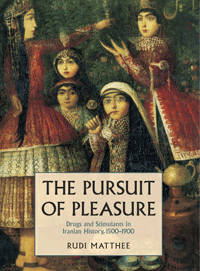 Sensationalism vs. Rationalism Sensationalism vs. Rationalism
The Sivand Dam: political sensationalism vs. archaeological rationalism
Kamyar Abdi
September 12, 2005
iranian.com
The responses (either public or private) myself and my colleague Professor Touraj Daryaee ["Safe & sound"] received to our recent posting regarding an alleged threat to the archaeological sites of Pasargadae and Persepolis as a result of the construction of the Sivand dam was far beyond our expectations. Many soon realized the absurdity of the claim and the logic in our argument and withdrew from the charade; some even took the time to complement us with kind words of encouragement for which we are grateful. But, despite our word and word of the others, the advocates of the claim and their misguided apostles not only insist on and continue with their ill-advised sensationalism, but they launched a personal counter-attack against us and not our argument, particularly turning Professor Daryaee into a punching bag with their pseudo-intellectual and quasi-nationalist arguments ["Not expendable"]. I therefore feel my fraternal responsibility to step in to deflect some of the pressure from the self-effacing Professor Daryaee while sharing some observations and ruminations.
First and foremost, we have to set the record straight: Professor Touraj Daryaee is a historian specializing in pre-Islamic Iran, whereas I am an archaeologist primarily interested in Iranian prehistory. History is not the same as archaeology and what historians and archaeologists do are different, but sometimes complementary. Historians primarily work with textual documents of later period, but archaeologists predominantly study the material remains of earlier (pre-literate) times. Apparently, for a number of individuals who took the time to respond to our posting, despite their alleged academic credentials, the distinction between history and archaeology is not entirely clear, often confusing the two of us and what we do. This leads us to our first observation:
As Professor Daryaee stressed before ["Drowning in noise"], among some expatriate Iranians the word of a single individual of European or American stock evidently carries more weight than that of two Iranians, regardless of their familiarity with the subject. Alas, despite living in farang or yengeh-donya for years and assertions to have reached enlightenment, these expatriate Iranians are modern-day examples of what, years ago, Jalal Al-Ahamd bemoaned as gharbzade (“Westoxicated”). While as a historian and an archaeologist somewhat familiar with the subject we stated the facts and our opinion, to satisfy the gharbzadeh yearnings of these fellow Iranians, we have solicited opinions from our European colleagues to strengthen our argument.
Also related, suffering from another old Iranian symptom, to many of these expatriate Iranians you can only be taken seriously if you are either a doktor or a mohandes. To them social sciences and humanities (including archaeology and history) are apparently not real science, but something like a “hobby” that one can pick up on his/her own by browsing a couple of general books. We find this attitude both amusing and frustrating, because we apparently wasted several years of our youth studying hard to earn a PhD in our respective fields from reputable universities, while we could have done a better job by simply reading a few books or surfing the internet over a weekend!
Apart from these minor quibbles, directly related to the question of Sivand dam and its threat to archaeological sites, we would like to reiterate our argument by establishing the facts. Once this is accomplished, it should be fairly easy to separate reality from fantasy.
Allow me to begin with the “petition” that launched this charade. This is in itself a fascinating document that will be saved for posterity as a top-notch example of twisting facts to promote a political agenda. Its obscure composition, poor grammar, and numerous misspellings (e.g., “Pasargad” for Pasargadae, “Persepolice” for Persepolis, “Archimedean” for Achaemenid or Achaemenian), its pretentious tone (e.g., making a declaration to the“... inhabitants of ... planet earth... ” [as if %99 of world would know or care about Pasargadae]), its customary quasi-nationalist remarks (e.g., “Cyrus the Great.. the first human being in power who has advocated for the rights of humans.. ”) are all signs of rudimentary and superficial knowledge about the subject.
 But, more importantly, is the petition’s bold reconstruction of the issue, as if the building of the Sivand dam is a grand conspiracy by the current government of Iran to destroy Iranian national heritage. One can begin to grasp the scale of this abuse by the comparisons made in the petition of the building of the Sivand dam with the torching of Persepolis by Alexander or deliberate destruction of Bamiyan Buddha by the Taliban. Apart from its obvious irrationality, this is a sign of unfamiliarity of the authors of the petition with what has transpired in Iran in the past twenty-five years, especially in the field of Iranian archaeology. But, more importantly, is the petition’s bold reconstruction of the issue, as if the building of the Sivand dam is a grand conspiracy by the current government of Iran to destroy Iranian national heritage. One can begin to grasp the scale of this abuse by the comparisons made in the petition of the building of the Sivand dam with the torching of Persepolis by Alexander or deliberate destruction of Bamiyan Buddha by the Taliban. Apart from its obvious irrationality, this is a sign of unfamiliarity of the authors of the petition with what has transpired in Iran in the past twenty-five years, especially in the field of Iranian archaeology.
As I have discussed elsewhere [see:
"Nationalism, Politics, and the Development of Archaeology in Iran," American Journal of Archaeology 105/1: 51-76], the current Iranian government backed away from its early revolutionary fervor and reached a rapprochement with Iran’s pre-Islamic past many years ago. There is no longer any reason or incentive on anyone’s part to destroy these monuments, especially through such time-consuming and expensive schemes as building a dam.
The main claim made by the document is that both Pasargadae and Persepolis are “on the verge of permanent extinction” as a result of the construction of the Sivand dam. This is a remarkable claim, one that in a typical Iranian manner is put forward without any supporting evidence. Needless to say, a dam capable of destroying both Pasargadae and Persepolis is truly an amazing architectural achievement that would have to defy the laws of physics, geology, and basic principles of civil engineering. How a single dam can store enough water in its artificial lake to flood two sites, one some 20 kilometers to its northeast (Pasargadae) and the other some 70 kilometers to its southwest (Persepolis) is beyond my comprehension.
Perhaps the authors of the petition realized the absurdity of their claim and soon dropped Persepolis from their list of “to-be-destroyed” sites, but Pasargadae, perhaps because of its close proximity to the dam, remained a prime target. However, after our response was published, we see a drastic change in the thrust of their argument. Apparently, Pasargadae is no longer in danger of flooding, but it may be damaged in some other way, perhaps as a result of increased humidity in the air. Finding this argument hard to sustain and facing the facts established in our letter, the focus of their argument gradually shifted to the sites in Tang-e Bolaghi, with passionate outcries about “one hundred unique archaeological sites” that will be destroyed as a result of construction of Sivand dam.
 Allow me to approach the issue in the form of a number of questions: Allow me to approach the issue in the form of a number of questions:
What exactly is the Sivand dam and why is it being built?
Despite the common use of the term “dam” which brings to mind massive constructions such as the Hoover Dam or Sadd-e Amir Kabir, what is being built on the Sivand River is more a “dyke” than a “dam”, designed and constructed to store the waters of the relatively small Sivand River, a tributary of the larger Kur River. The Sivand dam is being built to allow more controlled allocation of irrigation water towards thousands of acres of arable lands in the Arsanjan plain, thus substantially expanding its agricultural and pastoral capacity.
Is building of the Sivand dam necessary?
Of course the Sivand dam is not a matter of life and death for the local population, but building it is as necessary as any other dam in a developing country such as Iran.
Would Pasargadae be flooded as a result of building of Sivand dam?
No; even in the worst case scenario (rising of the lake above its highest predicted level, an unlikely scenario in light of general drought in the region for the past few years) the topography of Tang-e Bolaghi (a narrow valley) versus Pasargadae (a plain) would make this impossible.
Would the construction of the Sivand dam damage the remains at Pasargadae in any other way, e.g., increased humidity in the air?
Maybe, but this damage would not be any greater than what Pasargadae is already suffering through other degenerating elements, including the tourists who religiously visit the site (I will return to this point further below).
Would any other archaeological sites be destroyed as a result of construction of the Sivand dam, especially at Tang-e Bolaghi?
Yes; and this is why Iranian and foreign archaeologists are rushing to carry out as much salvage excavations as possible before the Tang is flooded.
How many sites are there at Tang-e Bolaghi and are there “unique”?
First, I have to set the record straight: I do not know how many sites are there in Tang-e Bolaghi; I have seen numbers any where from 30 to 130. As for “uniqueness” of these sites, one has to bear in mind that every archaeological site is unique, but not indispensable. Here lies a conundrum that archaeologists have been struggling with for many decades: how can we save the archaeological record in the wake of expanding development, i.e., dams, highways, housing projects, shopping malls, etc.? Sampling is archaeology’s response; it is obvious that excavating every archaeological site is impractical for many reasons: time, money, and personnel to name a few. Therefore, by excavating a large enough sample of the archaeological record we archaeologists hope to gain a representative profile of the archaeological past. This may sound “unpatriotic” to the laymen, but it is the only rational and realistic solution archaeology has come up with, and under present circumstances, there is no other practical alternative in sight.
 I must stress that hundreds of archaeological sites are being destroyed every day as a result of construction work or illicit excavations, not in Iran alone, but all around the world. In the past quarter of century, thousands of archaeological sites have been lost in Iran alone. For instance, eight years of war with Iraq took a heavy toll on archaeological sites in western Iran, a major loss that very few people noticed or paid attention to [See:
Kamyar Abdi, “A Visit to the Deh Luran Plain,” Antiquity 75/2: 247-50.] Even right now, many other dams are being built all over Iran, but most of them either lack a salvage archaeology component, or it is meager compared to that of the Sivand dam. (One notable example is the Karun 3 dam which will probably submerge twice as many archaeological sites as the Sivand dam; are the expatriate Iranians now going to raise the flag of patriotism for this one?) The Sivand dam and Tang-e Bolaghi is a case that gained exposure, exactly for the opposite reason, because it was one of the handful of examples that has been given a chance through salvage excavations and airtime in media. I must stress that hundreds of archaeological sites are being destroyed every day as a result of construction work or illicit excavations, not in Iran alone, but all around the world. In the past quarter of century, thousands of archaeological sites have been lost in Iran alone. For instance, eight years of war with Iraq took a heavy toll on archaeological sites in western Iran, a major loss that very few people noticed or paid attention to [See:
Kamyar Abdi, “A Visit to the Deh Luran Plain,” Antiquity 75/2: 247-50.] Even right now, many other dams are being built all over Iran, but most of them either lack a salvage archaeology component, or it is meager compared to that of the Sivand dam. (One notable example is the Karun 3 dam which will probably submerge twice as many archaeological sites as the Sivand dam; are the expatriate Iranians now going to raise the flag of patriotism for this one?) The Sivand dam and Tang-e Bolaghi is a case that gained exposure, exactly for the opposite reason, because it was one of the handful of examples that has been given a chance through salvage excavations and airtime in media.
In the complex system of the Iranian government, the Iranian Cultural Heritage and Tourism Organization (especially the Iranian Center for Archaeological Research) is only a minor department with limited resources and a handful of archaeologists. This organization is not floating in money (as some critiques may suggest), but receives funding barely enough to run its routine projects, let alone extracurricular activities such as a major salvage project. Further, like any other country in the world, when governments face budget deficits, research funds (especially in fields such as archaeology where there is no immediate monetary return) are first to be slashed. The Iranian Center for Archaeological Research is trying its best vis-à-vis Sivand dam and Tang-e Bolaghi considering what it has at its disposal; it should be commended (and not condemned) for what it has accomplished and sacrificed so far. (Maryam Rakhshani, the Director of the Pasargadae Complex was killed just a few days ago while working on part of the salvage project).
To sum up, we still believe that the claims about Sivand dam and its threat to archaeological sites is bloated and an attempt to settle a grudge with the current government of Iran. We find this a misuse of the archaeological record to promote a political agenda. Unlike advocates of the Petition and their followers, I, for my part, do not have the luxury of crossing the boundaries of political sensationalism and scientific professionalism.
I would like to conclude by adding a few words regarding the nature and sources of funding for archaeological research. At least one critique claims to have been stunned by our proposal for public support for funding archaeology ["Sharing the Same Anxiety"]. We are surprised to hear this critique coming from someone who is studying in the "Institute of Human Origins", a private organization with its budget almost entirely provided by private donors.
In fact, those familiar with funding for archaeological research in the US are well-aware that there are only two major state agencies to which archaeologists regularly apply: National Science Foundations and National Endowments for the Humanities. All other sources of funding are private organizations that receive their budget from non-governmental sources, mostly private donations. These include National Geographic Society and a multitude of private agencies such as Wenner-Gren, Mellon, Rockefeller, and Ford Foundations. Unlike what critiques may say, these are not charities for the wretched and the homeless, but funds established to support scientific (including archaeological) research.
 Allow me to illustrate the point about funding by returning to a problem I touched upon earlier: Pasargadae is in dire need of a comprehensive, sustained, and systematic conservation and preservation effort. The gradual deterioration of the monuments is neither a conspiracy nor anybody’s fault, but a consequence of the choice of material used by Achaemenid architects and years of exposure to natural elements. Iranian Cultural Heritage and Tourism Organization is doing its share to conserve and preserve the remains at the site, but it does not have the resources to undertake a conservation project on a massive scale. Allow me to illustrate the point about funding by returning to a problem I touched upon earlier: Pasargadae is in dire need of a comprehensive, sustained, and systematic conservation and preservation effort. The gradual deterioration of the monuments is neither a conspiracy nor anybody’s fault, but a consequence of the choice of material used by Achaemenid architects and years of exposure to natural elements. Iranian Cultural Heritage and Tourism Organization is doing its share to conserve and preserve the remains at the site, but it does not have the resources to undertake a conservation project on a massive scale.
Three years ago, after reading the reports of a major conservation and preservation project on Buddhist grottos in northeast China [N. Agnew, ed. Conservation of Ancient Sites on the Silk Road. Los Angeles, 1997 ] by an international team including tens of experts from China, US, and Europe, I briefly explored the possibility of initiating such a project at Pasargadae. Alas, I had to abandon my plans when my initial assessment suggested that the cost of such project would be in hundreds of thousands of dollars. This is a cost beyond the abilities of a single government agency, be that in Iran or any other country. This is just one of many examples of urgent needs in Iranian archaeology. If we are truly concerned about Iran’s national heritage, perhaps establishing a fund and contributing to such fundamental works is a good place to start.
About
Kamyar Abdi is Assistant Professor of Anthropology at Dartmouth College in Hanover, New Hampshire.
|